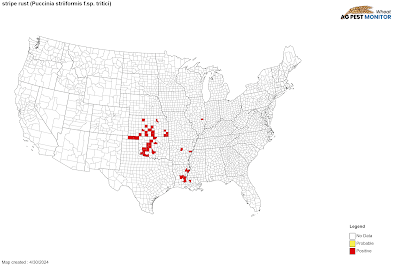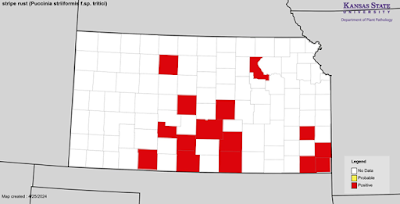T.K. Turkington, R. Aboukhaddour, and B.
McCallum.
Previous PCDMN blog posts have highlighted
potential emerging stripe rust issues in the USA; unfortunately, this may mean
stripe rust issues for Prairie wheat growers. The most recent reports from Dr.
Chen, USDA-ARS and Washington State University (WSU), indicated continued development
of stripe rust in research plots and commercial fields (https://smallgrains.wsu.edu/stripe-rust-24/, https://striperust.wsu.edu/2024/04/28/stripe-rust-update-april-26-2024/).
Incidence levels in commercial fields were
generally low, although Dr. Chen did observe a hot spot of elevated severity in
a commercial field. Dr. Chen cautions
that forecast cool weather and rainfall could promote further development of
stripe rust. As mentioned previously Dr. C. Hagerty of the Columbia Basin
Agricultural Research Centre (CBARC), Oregon State University also reported
stripe rust on susceptible lines at the CBARC, Pendleton, OR and encouraged
growers to scout and consider fungicide application (https://osu-wams-blogs-uploads.s3.amazonaws.com/blogs.dir/2823/files/2024/04/2024_April_Rust.pdf). Recent X (formerly Twitter) posts from Dr. D.
Larkin, wheat Breeder Limagrain, April 18, 2024, (https://twitter.com/dylarkin/status/1781102306593050890)
Reports continue regarding stripe rust in
Texas, Oklahoma and Kansas, and these early observations suggest these regions
may experience severe stripe rust epidemics if conducive weather occurs over
the next several weeks. Maps from Kansas
State University and AG PEST Monitor: Wheat, indicate stripe rust development
in numerous counties in Oklahoma and Kansas (Figures 1 and 2, https://wheat.agpestmonitor.org/stripe-rust/,
https://eupdate.agronomy.ksu.edu/article_new/stripe-rust-distribution-and-risk-assessment-for-kansas-april-25-2024-589-5).
As mentioned in the PCDMN blog post from
April 19, 2024, Drs. S. Liu, B. Gerrish, and J. Rudd, Texas A&M University
reported stripe rust, as well as leaf and stem rust of wheat, and crown and
stem rust of oat in Texas (https://varietytesting.tamu.edu/wp-content/uploads/sites/17/2024-Wheat-Rust-Report.pdf). Earlier in April, Dr. M. Aoun, OSU reported
that stripe rust potentials were high in Oklahoma and timely scouting by
farmers was encouraged (https://spotlight.okstate.edu/wheat-pathology/2024/04/02/wheat-disease-update-2-april-2024/,
https://www.farms.com/videos/crops/scout-for-stripe-rust-209386.aspx). Most recently, Dr. M. Aoun reported increased
levels of stripe rust on winter wheat at Stillwater and Chickasha, OK, while
leaf rust was also noted (https://twitter.com/OSUwheatdisease/status/1784421264242720939).
In an article by L. Vihauer, High Plains
Journal, Dr. M. Aoun indicates significant development of stripe rust in SE
Oklahoma, although conditions are dry and rain is needed, which will increase
stripe rust risk (https://hpj.com/2024/04/19/stripe-rust-a-concern-in-oklahoma-wheat/). On April 29, 2024, Dr. B. Carver, Oklahoma
State Wheat Improvement Team also mentioned continued development of leaf rust
on winter wheat in central regions of Oklahoma (https://twitter.com/osuwit/status/1785003699426689353).
In western Canada, early development of
stripe rust in disease nurseries at Abbotsford and Creston, BC have been
reported by Dr. G. Brar, U of Alberta, formerly of UBC, and likely reflect
overwintering on winter wheat breeding lines (https://x.com/gurcharn_brar/status/1779910374051209644).
Overall, US rust risk forecasts and the
early widespread occurrence symptoms suggest the PNW and the Texas to Kansas
corridor may be important sources of stripe rust inoculum for Prairie wheat
growers in 2024. Currently, Prairie
winter wheat crops resuming growth are most at risk. Fortunately, most winter wheat varieties have
intermediate to high levels of resistance, although Radiant, CDC Buteo, AAC
Elevate, Broadview, and CDC Falcon are rated as susceptible (https://www.seed.ab.ca/variety-data/cereals/https://saskseed.ca/wp-content/uploads/2020/12/2024-Varieties-of-Grain-Crops.pdfhttps://www.seedmb.ca/pdf-editions-and-separate-section-pdfs/).
The Prairie Crop Disease Monitoring Network
(PCDMN) will be starting their weekly Prairie rust risk forecasts shortly, and these
can be found at https://prairiecropdisease.blogspot.com/p/cereal-rust-risk-report.html. Key management strategies for cereal rusts
include host resistance, scouting and awareness of emerging rust issues, and
timely fungicide application. Previous
PCDMN Twitter (X) and Blog posts provide additional background information on
potential yield losses due to stripe rust as well as the importance of
monitoring crops for cereal leaf diseases:
https://twitter.com/pcdmn/status/1306577312465522690
https://twitter.com/pcdmn/status/1280178253295169537
https://prairiecropdisease.blogspot.com/2022/06/scouting-and-risk-assessment.html
https://prairiecropdisease.blogspot.com/2023/07/end-of-season-assessment-of-cereal-leaf.html
https://twitter.com/pcdmn/status/1347656233243828224
 |
| Figure 1. USA stripe rust observations, April 25, 2024, courtesy of AG PEST MONITOR: Wheat, https://wheat.agpestmonitor.org/stripe-rust/. |
 |
| Figure 2. Stripe rust occurrence, Kansas, April 25, 2024, Agronomy eUpdates. Courtesy of Dr. K. Onofre, Extension Plant Pathologist, Department of Agronomy, Kansas State University, https://eupdate.agronomy.ksu.edu/article_new/stripe-rust-distribution-and-risk-assessment-for-kansas-april-25-2024-589-5. |

